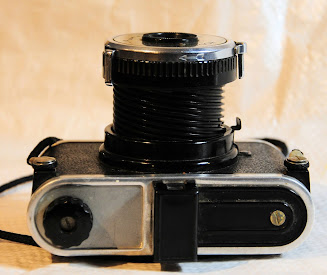This camera came from a friend's basement, where it had sat for quite some time. Other than the usual dust and grime that comes from sitting around, it was in great shape. There is some internal dust on the lens, but it did not seem to affect the negatives. It sat in a box for over a year after we moved to NC, and in preparation for a zine on toy cameras, I thought it would be worthwhile to give the camera a try. The Duex was manufactured from 1940-42, and my example came from Canada, and was manufactured there. It's hard to believe that the camera is about 80 years old. Yet, it's rather stylish, but still, a pretty simple camera.
The Duex is one of the few Kodak cameras that shoots 16 images on 620. The camera is unusual and readily identified by the large Bakelite helical that extends from the body to the proper length for taking photos. The lens has an aperture of f/11, and the shutter speeds are Instant ( ca. 1/30 sec) and Bulb. The base of the camera has a tripod socket. The direct vision viewfinder is centered on the top deck of the camera. The camera has a surprisingly comfortable feel in the hands, with its rounded, thin body.
There are a lot of potential toy cameras out there that would be ideal shooters if it were not for the fact that they require 620 film, which was discontinued by Kodak in 1995. It can be quite frustrating to a novice to pick up a nice vintage camera only to find that a spool of 120 film does not fit into it. For starters, any camera made by Kodak after 1931 that takes 6x4.5, 6x6, or 6x9 cm images uses 620 film. It's a different scenario when looking at vintage roll film cameras from Europe, most of which used 120 film. Of course, I had to re-spool a roll of film to test this camera, but with a changing bag and 2 620 spools it's quite easy. The reason for two 620 is spools is that I spool from the 120 to the 620, but of course, that roll would be backwards if used in the camera. So, I then spool from the first 620 spool to another 620 spool to get the film back into its original state. All done inside the changing bag, of course.
I took the Duex on a short trip to Marshall, NC and then along the French Broad River. I shot one roll of Tmax 100, expired in 2000. The images are really quite good, much to my surprise. I used a tripod on the long exposures, but otherwise, it was handheld. It's a little disconcerting turning it sideways to shoot in landscape mode, but the camera handles well.
The following scans are of the Tmax 100, developed in HC-110B for 6 minutes. HC-110 is recommended for expired films as it seems to keep the base fog down.
Actually shooting with the Duex really changed my mind about the camera. The images came out great, with very little distortion, and no vignetting. Certainly much better than a Diana. This camera now gets my vote as one that people should try shooting with. Since it has a tripod mount, you can use it in B mode, and if the light is too bright, or you want to go for the long exposure, you can tape a ND filter over the lens.











2 comments:
If you want a fancier way to attach a filter to the Duex, find a 1" (25.5 mm) Kodak Series V adapter ring and a 33.5 lens to 52 mm filter step ring. A regular 52 mm filter screws into the step ring, the step ring screws into the Series V adapter and the adapter slips onto the lens of the Duex. No tape.
Bill,
That's a great suggestion, and while I have all kinds of series filters and adapters, I hadn't even thought of it. Now I am off to my boxes of "stuff" (all well-labeled, of course!) to find the right adapters!
Cheers,
Mark
Post a Comment